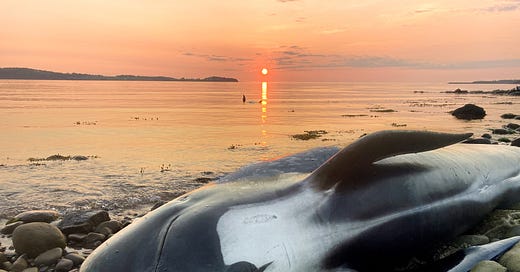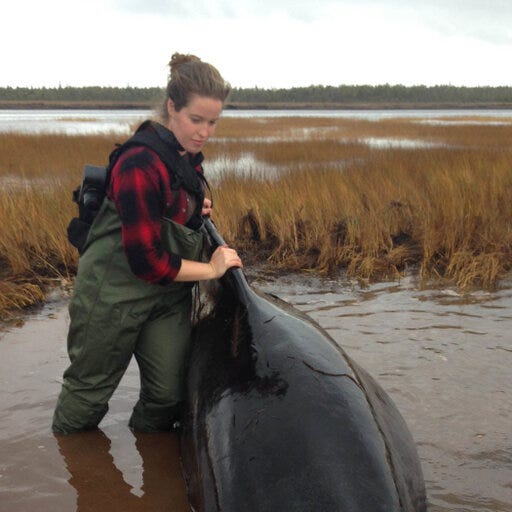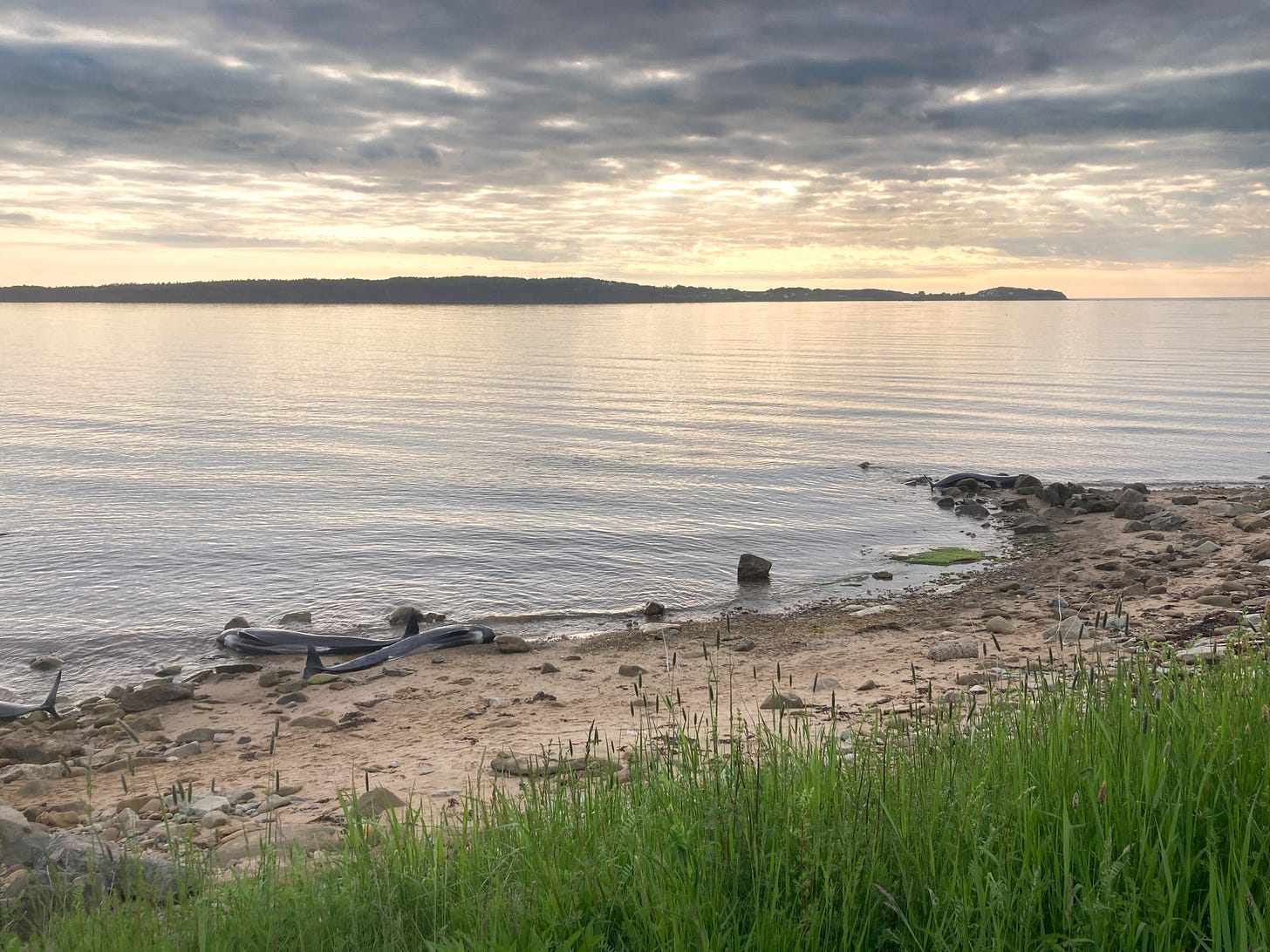Eleven long-finned pilot whales beached themselves on the shores of Cape Breton. This has happened before. The question is why?
By the time Elizabeth Zwamborn got to the rocky shoreline where highway 19 meets the southern entrance to Port Hood, Cape Breton Island, a number of local residents had already been trying franticly to save a group of long-finned pilot whales that had washed up on shore.
“We don’t know how long the whales had been there as no one saw them beaching themselves,” says Zwamborn. “But from what we understand there were 11 whales: eight died and three were re-floated by the attending public. We do not know the status of the re-floated individuals.”
Dead long-finned pilot whale on the beach near Port Hood, Cape Breton Island. Photo courtesy Elizabeth Zwamborn.
Zwamborn is a doctoral candidate at Dalhousie University and runs the Cape Breton Pilot Whale Project, which has been studying the social structure, vocalizations, and collective decision-making of long-finned pilot whales off northwestern Cape Breton since 1998.
When Zwamborn first arrived at the scene, she wanted to know if any of her “catalogued” whales had stranded. Whale researchers use photos to help them identify individual whales. Readers might be familiar with the North Atlantic Right Whale Catalogue, which includes more than 2 million photographs of 782 right whales dating back to 1935. The photos capture characteristic features that are unique to each individual whale, which helps researchers monitor whales’ where-abouts, habitat-use patterns, and mortality, among other things. Through photo-cataloguing, family trees have been created going back in time.
Zwamborn says that only three of the dead whales on the Port Hood beach had nicks and notches on their dorsal fins that were prominent enough to have been included in the pilot whale project’s catalogue.
“Of these, only one would have been considered distinct and it was one that we have documented in the past during our study. Unfortunately, it will take some time to look through the database and gather this information as it was not one of our most common whales.”
The Cape Breton Pilot Whale project includes a total of 2,500 individual whales, 51% of the population documented since 1998. The other 49% have dorsal fins without any distinctive notching.
“I am waiting on further photos from the living whales they shepherded out of the bay to see if any of those are a match,” explains Zwamborn in an email exchange.
Elizabeth Zwamborn
Tonya Wimmer is the Executive Director of the Marine Animal Response Society (MARS). She says her group has been onsite since June 11th when they received a call that 11 whales had stranded. A MARS response team was dispatched from Halifax and met DFO Fisheries officer teams from Cheticamp and Pictou onsite.
By the time they arrived, 8 animals were already dead and local residents had managed to pull 3 live animals back into the water.
“Once there, a larger pod was observed swimming slowly off Port Hood Island,” she tells me. “Given their behaviour and proximity to shore, the decision was made to go out the next morning by vessel to examine the animals.”
Aboard 2 DFO vessels, MARS and DFO examined the group of animals in the morning and decided to attempt to herd the animals out of the shallow area to deeper waters beyond the Island.
Wimmer says that “after [about] 2.5 hours and with incredible and careful vessel operation by the officers, the animals were successfully herded to deeper waters. In total there were 29 animals. The group was a mix of females and males and a range of ages with 5 animals being nursing calves. This is in addition to the 8 animals which passed (5 females, 3 males).”
According to a spokesperson from the Department of Fisheries and Oceans (DFO), it is unknown if the three pilot whales that were rescued from the beach were able to rejoin the pod.
Long-finned pilot whales on the beach in Port Hood, Cape Breton Island. Photo courtesy Elizabeth Zwamborn.
The thorny question of ‘why’?
According to the Department of Fisheries and Oceans, “Pilot whales are known to strand themselves individually or in groups from time to time. Although the phenomenon is not well understood, the stranding of groups of pilot whales is not uncommon worldwide.”
I ask Zwamborn if she’s seen anything like this before.
The last mass stranding we had in Cape Breton was in 2015 in Judique, fairly close to this stranding. The year (2014) before we also had a mass stranding of long-finned pilot whales near Summerside PEI. Last year there was a late season stranding in Newfoundland as well. They are unfortunately not uncommon occurrences. We know from past research around the world that there are a number of natural causes (confusion, inability to navigate shallow areas, following sick individuals, etc.), but that strandings can also be caused by human activities as well. We will not be able to say much about this stranding until necropsies on all the dead individuals have been conducted, but given that this is an area of frequent strandings it is certainly possible that confusion and ending up in a place they weren't able to navigate out of could have contributed to this particular stranding. This is why it is so important that necropsies are done after events like this.
Zwamborn says that often, after mass stranding events, necropsies aren't done as there is an overwhelming number of whales to deal with. But she says that without them, the cause of death remains a “mystery.”
Fortunately, there will be some information regarding these whales coming on the horizon.
Wimmer tells me that the MARS team returned to Cape Breton this morning to conduct the necropsies in collaboration with veterinary pathologists from the Canadian Wildlife Health Cooperative at the Atlantic Veterinary College.
Zwamborn adds there have been other strandings around the world have been attributed to hearing loss.
“With sound being so very important to whales, it essentially is the equivalent of being blinded to us. Sounds such as military sonar, seismic surveying, and underwater explosions have been known to cause hearing damage. However, it is important to note that while these activities do cause strandings sometimes, there are many other natural causes that also lead to these events.”
There have been mass strandings of whales – particularly beaked whales – associated with the use of sonars, both naval and commercial. But the causes of these strandings continue to be a topic of debate in the scientific literature: does the high acoustic pressure damage the whales directly, or is the particular stranding due to some extreme reaction to the very loud noise?
There is also the possibility that exposure to sonar, or seismic arrays, may not necessarily result in a whale stranding, but it might cause either permanent or temporary hearing damage, making it more difficult for whales to communicate, find food, or avoid predators.
According to a media spokesperson from National Defence, “there has been no Royal Canadian Navy sonar activity in the [Port Hood] area in the last few days/ weeks.”
Jessica Lamirande says the Canadian Armed Forces has developed procedures to mitigate against harming marine mammals.
These procedures include but are not limited to the requirement to maintain visual surveillance of operating areas by watch officers and lookouts, monitoring of passive systems as a means to detect marine mammals, as well as the use of a mitigation avoidance zone within which activities will cease if marine mammals come within a certain distance. When whales are seen, Royal Canadian Navy (RCN) ships give way to them and give as wide a berth as possible.
Rocky shoreline near Port Hood where 11 long-finned pilot whales stranded on June 11, 2023. A group of young teens spotted the whales in distress and tried to save them. Eight whales died and three were re-floated with the help of many community members.
Seismic testing is also a potential culprit but it’s an area where there appears to be a bit of scientific vacuum. Since the 1960s, oil and gas companies have collected roughly 60,000 km of seismic data in the Gulf of St. Lawrence alone, probing deep beneath the ocean floor and using sound to create a picture of the rock formations—some of which are associated with the presence of oil and gas. The sound explosions are produced by what are called air guns, which emit blasts at regular timed intervals—every ten seconds or so for twenty to thirty days. Underwater microphones receive the sound when it is reflected by the undersea rocks.
The sound pulse generated by an air gun array from a distance of one metre underwater is 255 decibels (dB)—louder than a lightening strike on water but quieter than a seafloor volcanic eruption. Since so few studies have been done on this topic, little is known about the effects of the noise produced by seismic operations on the behaviour and health of marine organisms, including whales. But studies that do exist suggest that marine animals, especially those that can hear, can experience permanent physical damage if they happen to be near a gun blast. Whales navigate and communicate by echolocation—a natural form of sonar—and extreme noise can cause hemorrhaging around the ears. Over the years mass strandings have occurred in the vicinity of navy sonar exercises. It is believed that air gun noise is actually more damaging.[i]
At this time, it is unknown if there was seismic activity in the vicinity of the stranding.*
Zwamborn also points me to a 2013 study that appeared in the Journal of Heredity that also explores how the breaking of social bonds/connections during pre-stranding might lead to stranding events in some cases. For instance, the authors found that dependent calves were often separated or absent from their mothers during mass strandings, which suggests that “disruption of kinship bonds” from “interactions among unrelated social groups during feeding or mating aggregations” could play a “causal role” in these events.
While it’s still too early to tell what the cause of the mass stranding in Port Hood was, it points to the complex social dynamics—you could call it culture—among cetaceans.[ii]
According to Wimmer, more information as well as visuals, including drone footage of the herding, will be available once the necropsies are complete.
The results will be reported here as they become available.
* Since this article was posted, I heard back from a spokesperson at the DNRR who assured me that “currently there are no seismic programs being done” in the province.
[i] This section on seismic testing is adapted from my 2013 book, The Devil and the Deep Blue Sea: An Investigation into the Scapegoating of Canada’s Grey Seal.
[ii] Zwamborn is also part of the Whitehead Research Lab, based out of the university’s department of biology, and named after Hal Whitehead, who is best known for his research on the behaviour, social structure, population biology and conservation of sperm whales in the eastern Pacific, and the northern bottlenose whale of the north Atlantic. His recent book, The Cultural Lives of Whales and Dophins—which I will return to in greater depth in a future post—Whitehead argues that cetaceans not only have complex social structures, but they have developed culture, which is transmitted much like language, tastes in food, and modes of dress are passed on in human cultures.








I hoped that you'd be on this and help us to understand. Thank you.